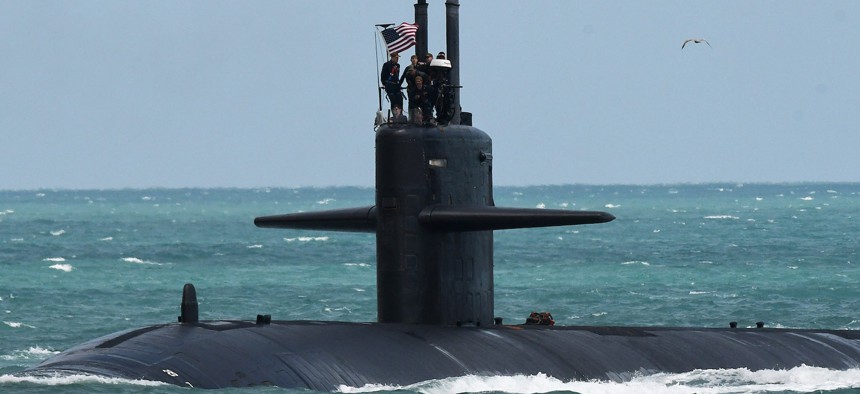
A nuclear-powered U.S. Navy submarine cruises into the Navy Port at Port Canaveral in March 2023. Paul Hennessy / SOPA Images / LightRocket via Getty Images
Budgetary limbo could cost the Navy Department $26B in missing or ‘misaligned’ funds
Comptroller lays out the price of a full-year continuing resolution if Congress can’t pass a 2024 budget.
Up to one-tenth of the Navy and Marine Corps’ planned 2024 funding will be cut or constrained if Congress can’t pass a budget, the Navy’s top financial officer said Monday.
“If I get stuck at sequester, that's a $15-billion hit to the Department of the Navy. If I got stuck in a full-year CR—continuing resolution—“that's $26 billion of misaligned funds. A tenth of the Navy's budget is all screwed up,” Rumbaugh said at a Stimson Center event.
That latter number may be a bit high, he said, because it includes money for the second Columbia-class submarine, which like all Navy subs is so expensive that it normally counts as a new-start program—the kind that cannot begin under a CR. But Congress has specifically allocated funding to get started on it.
“So how that affects the $26 billion number, it helps me a little bit. Nevertheless, I'd like to solve all those problems. And again, just give my team more certainty,” Rumbaugh said.
Defense officials routinely talk about how disruptive delayed funding can be. Rumbaugh said the Navy is prepared regardless, but is hoping and planning for a $255.8 billion budget for fiscal year 2024.
“I look around the world and I think the Department of the Navy's the answer, and I absolutely think we should get that increase. That's the preparation we're going on. And more importantly, I'm a month out from needing another appropriations bill,” he said. “I'd like to get my final appropriations bill. What is the top line? Hey, the administration has already proposed supplemental funding for Ukraine. We're exploring other supplemental funding. Those things all make a difference in what we go do.”
If Congress doesn’t pass funding bills by the New Year, per the recently passed Fiscal Responsibility Act, government agencies could be forced to make sequestration cuts.That means if there’s still a continuing resolution on Jan. 1, 2024, the Pentagon will have to operate at 2023 budget levels minus 1 percent. The caps are lifted once permanent funding is passed.
“We expect that we will be able to take milpers off the table, the military personnel funding,” he said. “That's good, but it means all my other accounts have to burn more” in programs, projects, and activities.
The Navy, which has ships on standby to assist Israel in its current conflict with Hamas, is also working to replenish its stockpiles.
“We've had presidential drawdown authority for a long time…that allows us to send stuff in a very quick turnaround. We have now added the financial management community into that process,” Rumbaugh said. “The next part of that is replenishment, refilling my stocks, making sure that the U.S. has the tools and has the weapons we have.”
When it comes to war, he said, operational and budgetary perspectives are aligned: “don't run out of weapons.”
The Navy is expecting a 30 percent bump in its weapons-buying accounts for 2024, he said.
“We were very proud of increasing our munitions weapons procurement account request by more than 30% in FY24. And that is not in the supplementals, that's backfilling. But actually trying to get ahead of the game, we are absolutely looking at the other vehicles to look at what other challenges in the world might require us to prepare.”






